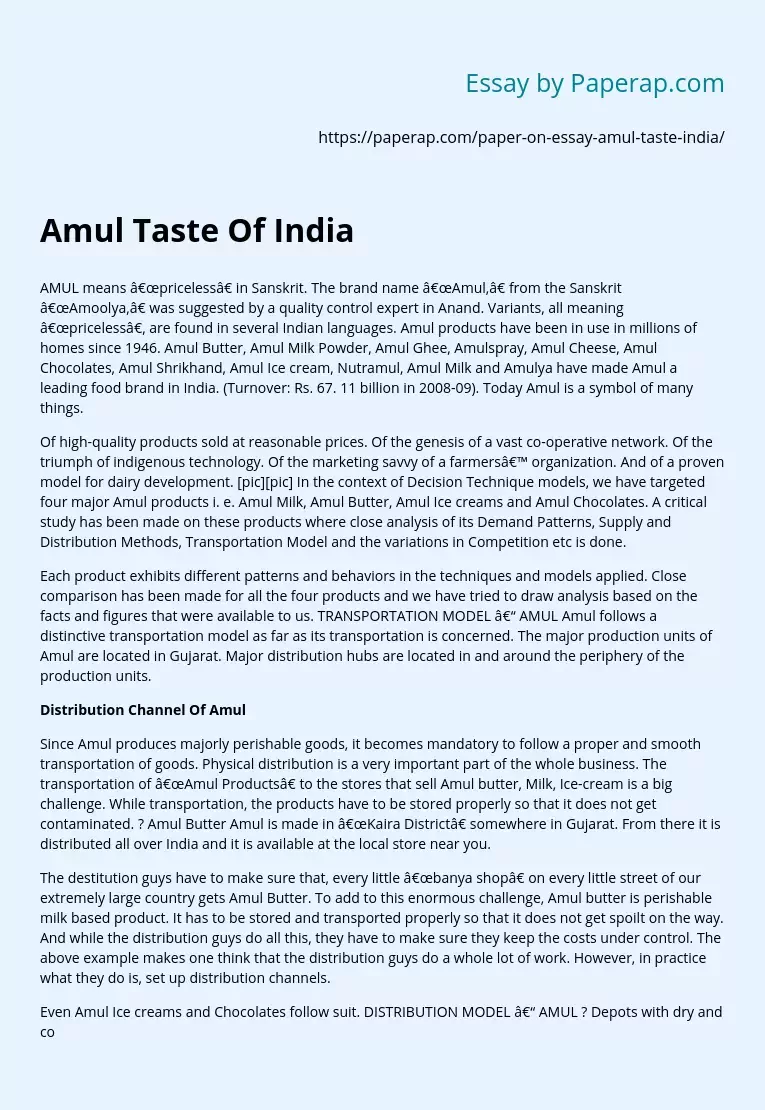Amul Taste Of India
AMUL means “priceless” in Sanskrit. The brand name “Amul,” from the Sanskrit “Amoolya,” was suggested by a quality control expert in Anand. Variants, all meaning “priceless”, are found in several Indian languages. Amul products have been in use in millions of homes since 1946. Amul Butter, Amul Milk Powder, Amul Ghee, Amulspray, Amul Cheese, Amul Chocolates, Amul Shrikhand, Amul Ice cream, Nutramul, Amul Milk and Amulya have made Amul a leading food brand in India. (Turnover: Rs. 67. 11 billion in 2008-09). Today Amul is a symbol of many things.
Of high-quality products sold at reasonable prices. Of the genesis of a vast co-operative network. Of the triumph of indigenous technology. Of the marketing savvy of a farmers’ organization. And of a proven model for dairy development. [pic][pic] In the context of Decision Technique models, we have targeted four major Amul products i. e. Amul Milk, Amul Butter, Amul Ice creams and Amul Chocolates. A critical study has been made on these products where close analysis of its Demand Patterns, Supply and Distribution Methods, Transportation Model and the variations in Competition etc is done.
Each product exhibits different patterns and behaviors in the techniques and models applied. Close comparison has been made for all the four products and we have tried to draw analysis based on the facts and figures that were available to us. TRANSPORTATION MODEL – AMUL Amul follows a distinctive transportation model as far as its transportation is concerned. The major production units of Amul are located in Gujarat. Major distribution hubs are located in and around the periphery of the production units.
Distribution Channel Of Amul
Since Amul produces majorly perishable goods, it becomes mandatory to follow a proper and smooth transportation of goods. Physical distribution is a very important part of the whole business. The transportation of “Amul Products” to the stores that sell Amul butter, Milk, Ice-cream is a big challenge. While transportation, the products have to be stored properly so that it does not get contaminated. ? Amul Butter Amul is made in “Kaira District” somewhere in Gujarat. From there it is distributed all over India and it is available at the local store near you.
The destitution guys have to make sure that, every little “banya shop” on every little street of our extremely large country gets Amul Butter. To add to this enormous challenge, Amul butter is perishable milk based product. It has to be stored and transported properly so that it does not get spoilt on the way. And while the distribution guys do all this, they have to make sure they keep the costs under control. The above example makes one think that the distribution guys do a whole lot of work. However, in practice what they do is, set up distribution channels.
Even Amul Ice creams and Chocolates follow suit. DISTRIBUTION MODEL – AMUL ? Depots with dry and cold warehouses to buffer inventories of the entire range of products. ? Transacts on an advance demand draft basis from its wholesale dealers instead of cheque system adopted by other major FMCG companies. ? Wholesale dealers carry inventory that is just adequate to take care of the transit time from the branch warehouse to their premises. ? This Just- In – Time inventory strategy improves dealers Return on Investment (ROI). All GCMMF branches engage in route scheduling and have dedicated vehicle operations. ? If product crosses the shelf life, the retailer bears the costs. ? If the product gets spoiled during the transportation or if there is any customer complaint, Amul bears the costs. ? Unsold goods are not returned to the manufacturer. ? No reverse logistics is applicable in case of Amul. ? Amul Parlors have been established to shorten the transportation channel. It has succeeded in setting up 2300 parlours in 2007-08 and has a goal of setting up 10,000 outlets by March 2010.
Partners in Distribution ? Amul added 1200 distributors in small towns in India in 2007-2008. ? The total numbers of distributors in India is 6828. ? Total number of dealers in India – 3666. Assets in Distribution ? Amul has a range of 40 product categories covering a wide range of milk products. ? It has a vast storage system with 300 stock keeping units. ? It has 47 depots. 100,000 retailers with refrigerators. ? It has an 18,000 strong cold chain. It has 500,000 non – refrigerated retail outlets. It provides Decentralized facilities.
Amul Taste Of India. (2019, Dec 05). Retrieved from https://paperap.com/paper-on-essay-amul-taste-india/

